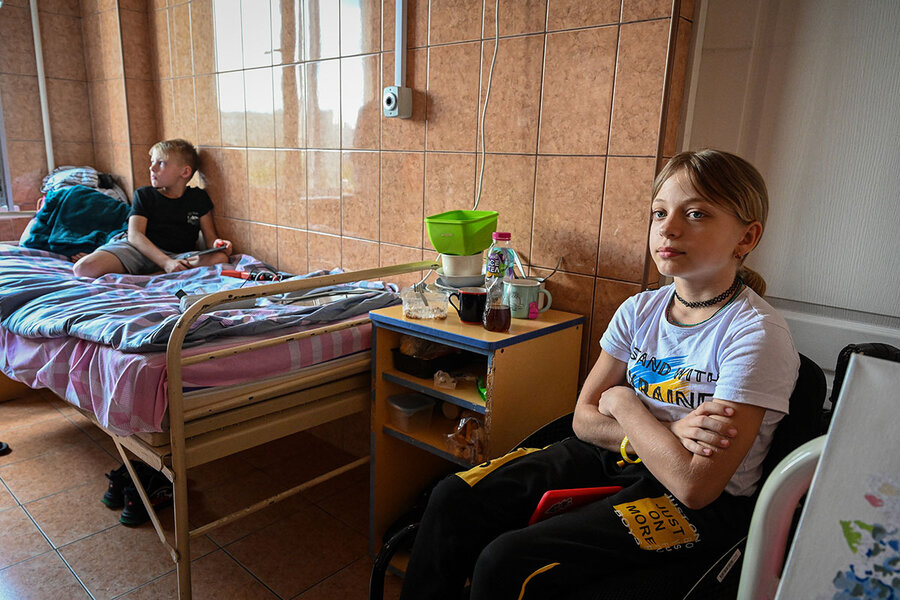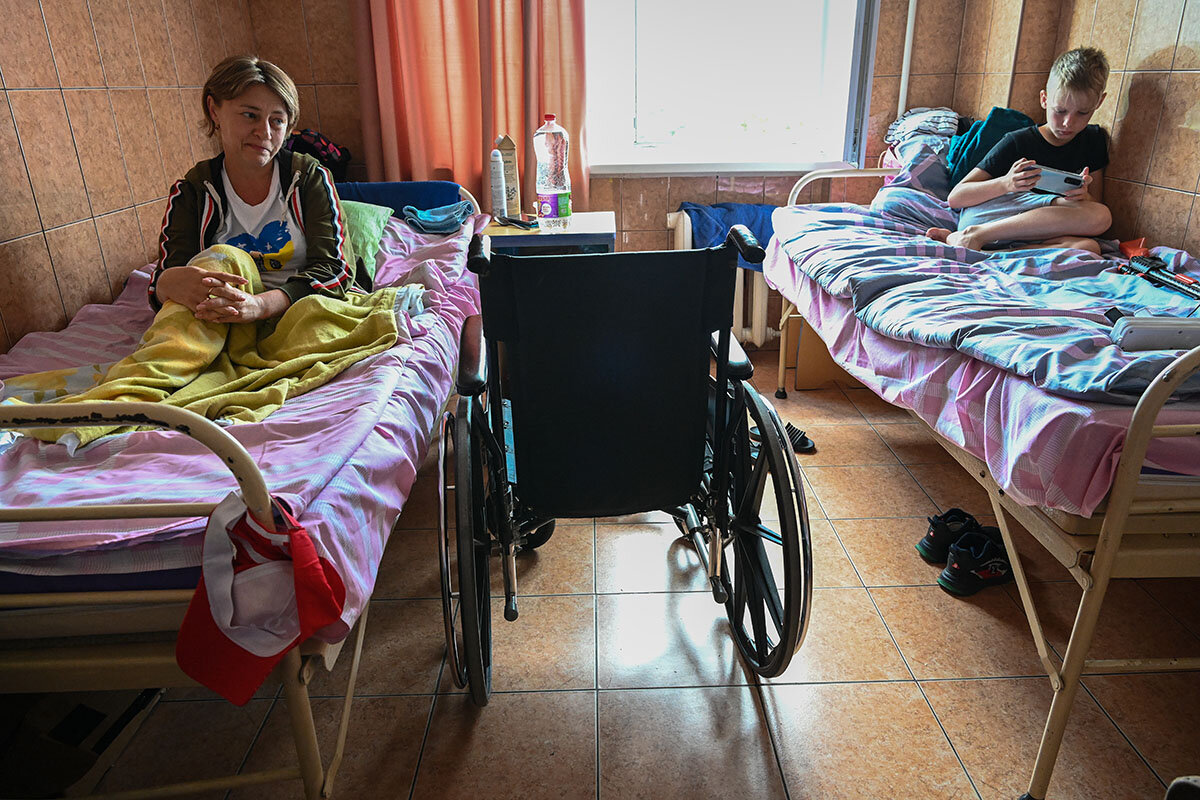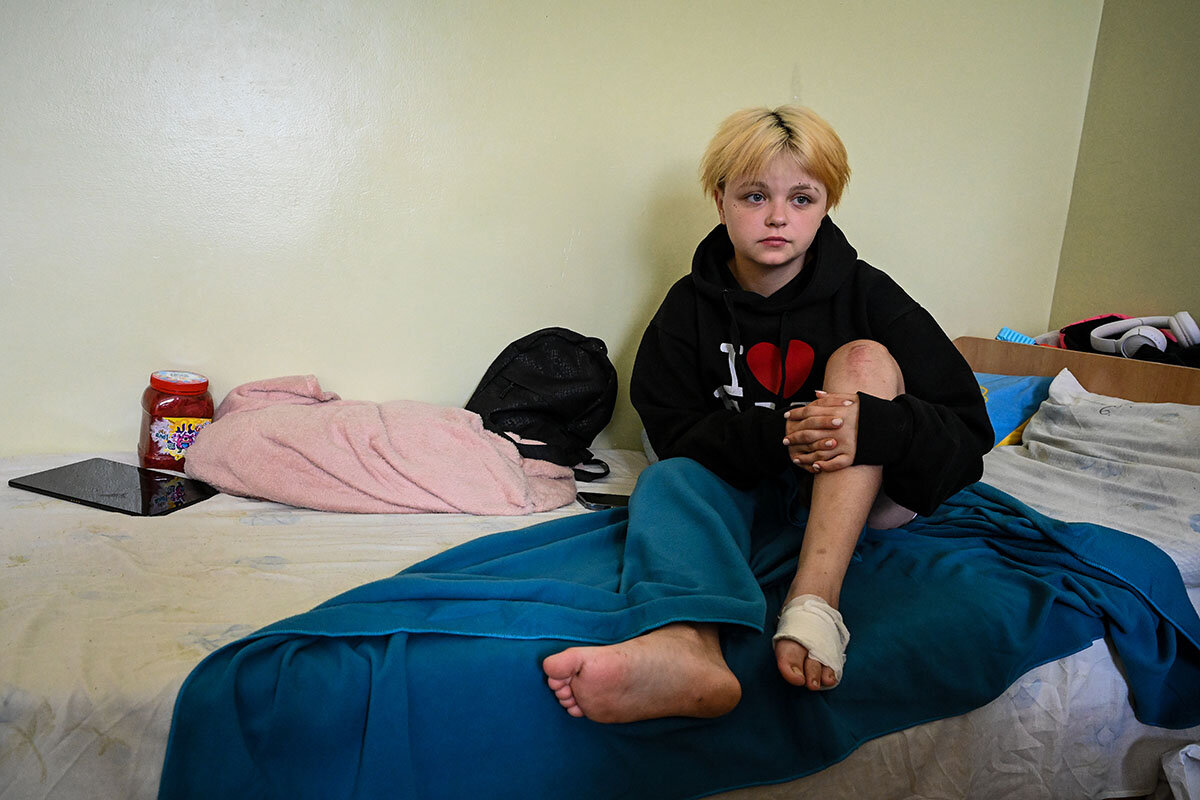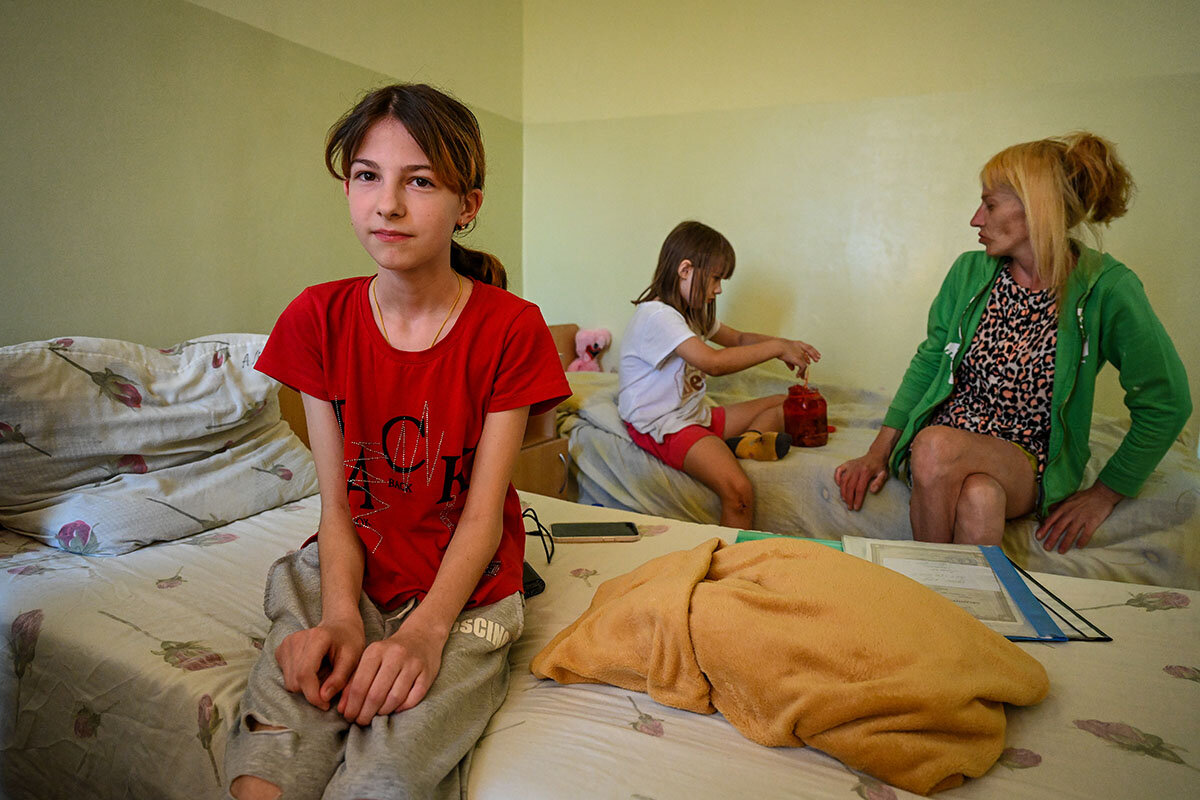Ukraine: Three girls wounded by war, three paths toward healing
Loading...
| LVIV, Ukraine
The three Ukrainian girls are in the same Lviv hospital, recovering from severe war wounds.
But the violent impact of Russia’s war on them – which at once abruptly ended their youthful innocence and imposed new requirements of resilience, coping with trauma, and even bravery – has sent their lives on very different trajectories.
As this war enters its fifth month, the separate story arcs of these three girls encountered one day last week, who look to the future now with permanent scars, are emblematic of how the conflict has skewed the lives of tens of thousands of Ukrainians wounded by war.
Why We Wrote This
A story focused onWhat the three young Ukrainians share is girlhood interrupted by a war that left them wounded. How each processes that and finds her way toward resilience, with help or alone, is unique.
Yana Stepanenko smiles for visitors and wears a “Stand With Ukraine” T-shirt, but the 11-year-old quietly excuses herself when asked about the early April day that a Russian rocket landed on the train station in Kramatorsk, taking both of her legs – and one of her mother’s.
Still overwhelmed by the memory, she silently rolls back her wheelchair and exits the small hospital room, leaving behind her mother and twin brother, Yaroslav, who plays with a toy rifle and mobile phone and was untouched by the attack. He was in the train station building, watching the luggage, while mother and daughter were outside on the platform.
This week the family flies to San Diego for specialist care and prostheses.
“I am shocked to be in this situation,” says mother Natalia Stepanenko, who now requires her own wheelchair. She wipes away tears as she describes how Yana is “in more of a good mood,” and OK during the day but not at night.
“You have to be tough”
The trauma ebbs and flows. Spirits rose when one visitor showed pictures of athletes fully active in wheelchairs. “It was very nice, that hope,” says Ms. Stepanenko.
The shock began immediately after the Russian cluster munition landed in the midst of thousands of would-be evacuees thronging the Kramatorsk train station in eastern Ukraine’s Donbas region on April 8, killing some 59.
Yana and her mother were taken to different hospitals in Dnipro, a large transport hub to the west. For 20 days, mother and daughter were gravely wounded – and apart.
“She would call in the evening and cry, and I would cry, and I would say: ‘You have to be tough,’” recalls Ms. Stepanenko. Adding to their agony, Yana’s father, Vasyl, who had been in the Ukrainian army since 2015, was killed May 11, fighting on the front line in the Donetsk region.
The family has mixed emotions about flying to San Diego and living in the United States for a year during treatment, in an arrangement worked out by the Lviv City Clinical Hospital for Children.
“A lot of acquaintances tell us to stay in the U.S.,” says Ms. Stepanenko. But from this small hospital room, already the breadth of Ukraine away from home, the southwestern corner of America seems very, very far away.
“I tell them: ‘If you are so smart, why don’t you leave yourself?’” she says.
“It was OK in the beginning” when they accepted the U.S. trip, adds Ms. Stepanenko, loosing another tear. “But now it is so close.”
They call her “Schumacher”
Three floors below at the hospital, 15-year-old Anastasia Pryhoda describes a vastly different experience, and a precocious ability to cope.
She recounts how she was at the wheel, evacuating several wounded adults from her hometown of Popasna in eastern Ukraine, when Russian troops opened fire on their car.
First taught to drive at the age of 7 by her mother, who has since died, she says she was the only one in her area willing to risk constant Russian shelling to drive wounded or older residents to safety. On frequent trips to the town of Bakhmut over the course of one month, often carrying five or six passengers, the young volunteer reckons she helped some 200 people reach safety.
Her surname means “adventure,” and the teen goes by Nastia. But she earned the nickname “Schumacher,” after the German Formula One driving legend Michael Schumacher.
With short dyed hair, pale pink nail polish, and black “I ♡ Paris” hoodie – never mind the big dose of nonchalance – she dismisses the term “hero” used by friends, and says her actions were “regular.”
“No one was brave enough to drive; they were afraid of bombs,” recalls Nastia, matter-of-factly. “But I was not afraid. … If my mother would still be alive, she would do it. Half my friends think I am dead already.”
At first, the evacuation runs were easy and not overly dangerous. “There were far fewer shells hitting the road,” she says.
But as Russia withdrew from its failed advance on Kyiv, and focused its military efforts on seizing the eastern industrial heartland of the Donbas, Nastia’s pathways out of Popasna became increasingly tricky, and far more risky.
The moment of reckoning came May 1. Nastia says she assisted removing shrapnel from two wounded men, and, along with the wife of one, and a man who knew directions, they began driving out of Popasna.
Suddenly, at one corner where Ukrainian troops should have been, the teen driver saw the red armbands and uniforms of half a dozen Russian soldiers. They opened fire from 10 yards, she says, and the car stalled.
The least wounded man leaped out to push the car, which restarted. He was hit with bullets in the arm, and Nastia kept driving a couple of miles before the car stopped for good.
She had been hit with four bullets and shrapnel in her right knee and left foot – she lost a small toe in the firestorm – and she bled from head lacerations caused by glass from the smashed windshield. But they were close enough to Ukrainian troops to be rescued.
“I don’t think I am a hero, as people say,” says Nastia. “I was hit by bullets. When a bullet is coming into you, it feels like a thread on the thigh. I didn’t feel anything for an hour.”
Now that she has recovered, while listening to Ukrainian music, and with a pillow on her bed in the national colors of blue and yellow that reads “Everything is going to be Ukraine,” she is ready to harness her assertive nature in a new way.
Her hometown of Popasna is now under Russian control. This week, Nastia will move to Kyiv to live with her aunt, and has a strong desire to enroll in a military academy to become an army officer.
“Never look back”
Yet just two hospital beds away, in the adjoining room, 12-year-old Kateryna Iorgu exemplifies continuing trauma from the Kramatorsk train station attack, which claimed her mother’s life and sent her own into a tailspin of uncertainty.
Katia was saved from the Russian cluster munition that day when a man threw himself upon her diminutive frame – though he died while protecting her.
Two surgeries have removed most of the shrapnel from her legs, but she walks with a limp and has lost weight. Crutches lean against the wall, though they are not used for short walks. Katia’s younger sister Yulia, age 8, unharmed in the attack, plays with a bucket of slime and a mobile phone with a rubber cat ear case on the next bed.
“I can walk for half a day, then spend two days in bed,” says Katia, who has bright eyes and earrings, and wears a ponytail and red T-shirt printed with the words “Never look back.”
Indeed, when asked about the event that brought her here, Katia’s face darkens, her lips curl up and lock, and her mouth stops working. She no longer responds to questions, even about her school or her favorite subjects.
“Speak, Katia,” implores the girl’s aunt, Olha Lialko.
“She can get stuck like this, because she is thinking about her mother, and her life,” says Ms. Lialko. Psychologists came twice and “tried to draw something” with Katia, but “didn’t get very far.”
There are still shrapnel fragments in Katia’s legs. But hopes of travel abroad for more surgery have been dashed, partly by delays in paperwork to make Ms. Lialko her official guardian, and now by assessments that only rehabilitation is needed.
This week, the family moves to Vinnytsia in central Ukraine, to live with a relative, and for Katia’s rehabilitation.
“We would like to go abroad, because rehabilitation is better there,” says Ms. Lialko. “We feel bad because everybody else goes abroad, but not us. It is senseless. We were here all this time.”
Contributor Oleksandr Naselenko supported reporting for this article.









